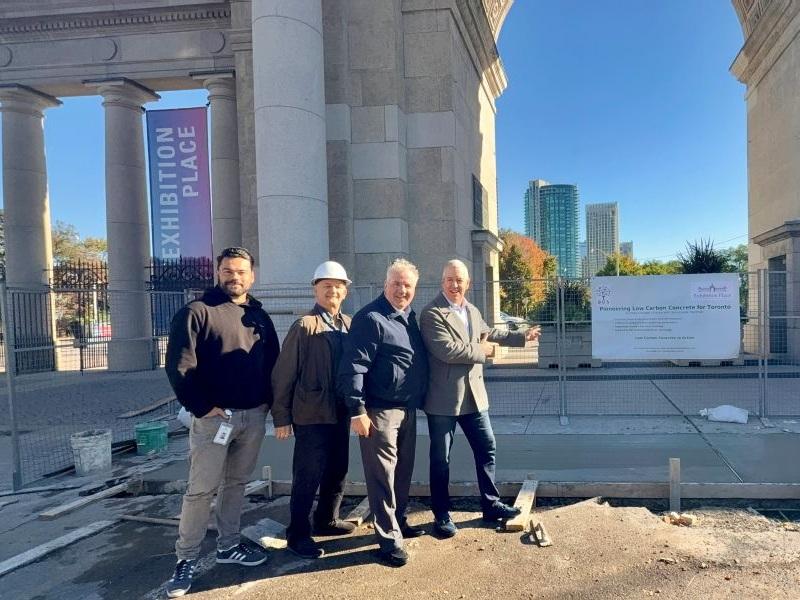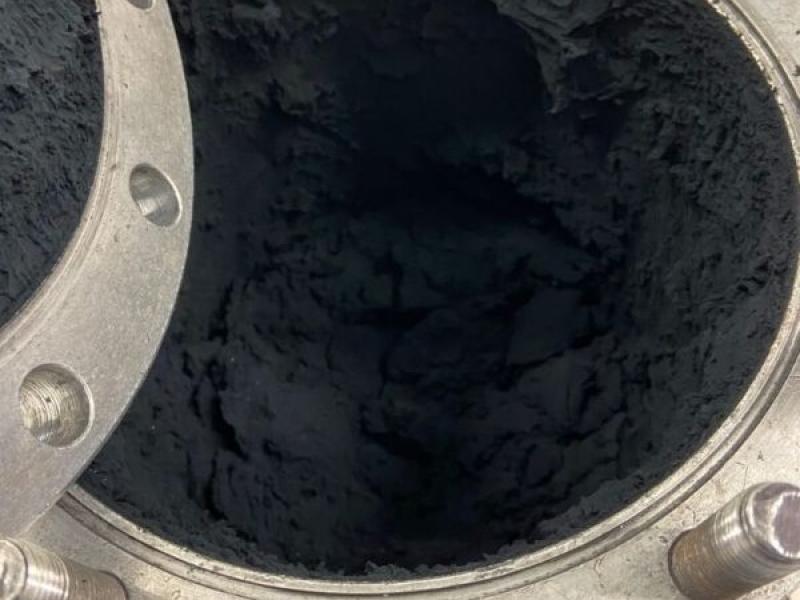
Lead figures behind the project to use graphene-enhanced concrete attend the pouring at Princes' Gate. Second from the left is Gary Van Dusen, the co-founder and CTO of Bio Graphene Solutions. Don Boyle, the CEO of Exhibition Place, is fourth from the left. (Courtesy Exhibition Place)
The seemingly ordinary concrete that was poured near the Princes’ Gates in Toronto in early October is actually a demonstration of an innovative mixture enhanced by graphene, resulting in lower carbon emissions and construction costs.
A project completed in partnership between Exhibition Place and Toronto-based Bio Graphene Solutions, less than a pound of graphene was blended into a truckload of concrete mix. It was then poured on a roadway in front of Princes’ Gates, an iconic arch at Exhibition Place, and on a nearby sidewalk.
The addition of graphene reduced the cement content of the pour, cutting hundreds of tonnes of carbon dioxide (CO2) without affecting the strength.
An ultra-strong material, graphene has grabbed industry-wide attention for its remarkable properties, including being 200 times stronger than steel. A tiny amount of graphene that supplements a concrete mix can reduce the need for carbon-intensive cement without hindering its strength, Gary Van Dusen, the co-founder and CTO of Bio Graphene, said in an interview.
“It’s a perfect application that’s real-world,” Exhibition Place CEO Don Boyle told Sustainable Biz Canada. The pouring of the low-carbon concrete is a first-of-its-kind effort for Exhibition Place, he added.
It is the second public demonstration of Bio Graphene’s enhanced concrete mix, after its collaboration with construction firms EllisDon and Tomlinson to pour the sidewalk of the Children's Hospital of Eastern Ontario in Ottawa.
Van Dusen said Bio Graphene is tackling the CO2 emissions from cement and concrete. The industry is responsible for emitting approximately eight per cent of the world’s climate-warming pollution.
“If we can impact that with graphene, that’s a great start.”
'A little bit' of graphene goes a long way
Exhibition Place is a Toronto landmark famous for hosting the Canadian National Exhibition every summer and being home to event venues such as the Queen Elizabeth Building and BMO Field.
With sustainability goals to meet, such as being net-zero by 2050, Exhibition Place management was motivated to explore the use of low-carbon concrete, Boyle said, leading it the innovation being pioneered by Bio Graphene. The company manufactures the graphene by breaking down carbon from organic materials, a process it says has less environmental impact than the more common process of exfoliating graphite.
To illustrate graphene's effectiveness, the pour at Exhibition Place involved “literally a handful” of the material to enhance tonnes of concrete, Van Dusen said. “A little bit does go a long way.”
Early test results have shown the graphene-enhanced concrete cures at a rate on par with standard concrete, Boyle said. Exhibition Place is "very happy with the strength,” he added. The addition of graphene is expected to reduce approximately 250 kilograms of CO2 compared to a typical truckload of concrete.
The beauty of adding graphene to the concrete is “that not only does it reduce CO2, it’s actually less expensive,” Boyle said, meaning Exhibition Place pays for less cement. Plus, with its high strength and flexibility, “it’s a win-win-win here,” he summarized.
A 'game changer'
Exhibition Place is very interested in more pours of graphene-enhanced concrete for infrastructure such as roadways, Boyle said. He hopes more projects will be finished in time for the FIFA World Cup soccer matches that will be held there next year.
“This product here is a game-changer,” Boyle said. “My vision is that this becomes a standard not only here in Toronto but municipalities throughout the province.”
Bio Graphene is working on concrete applications beyond sidewalks and pavement, Van Dusen said. It plans to provide graphene to large concrete producers in Ontario with the goal of supporting the production of precast concrete products used to make buildings.
Currently capable of producing one tonne of graphene per year, the company plans to expand its capacity to 60 tonnes per year over the coming months, Van Dusen said. It will open doors into more industries such as the critical minerals and batteries sectors, he said.










